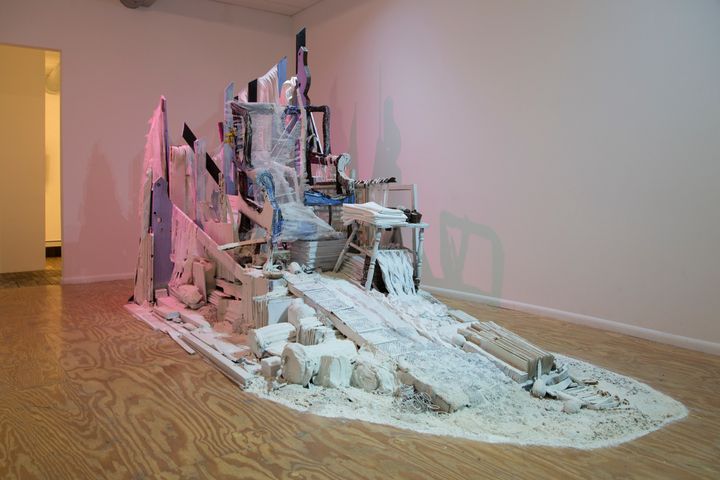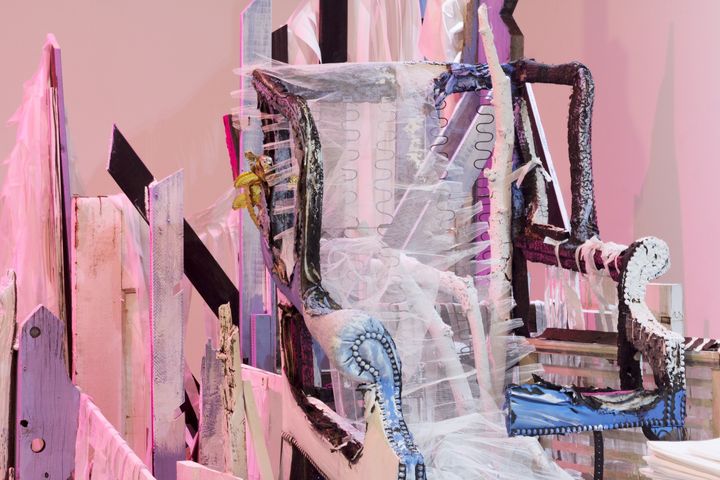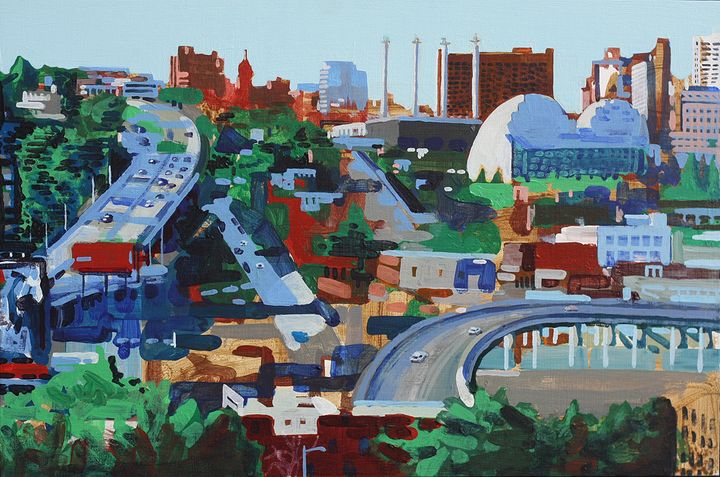Two concepts that speak of how re-urbanization in America looks today were shown in separate exhibitions across Kansas City, MO — Julie Schenkelberg: Solo Exhibition and New Paintings by Jason Needham. With very different processes, these artists critiqued a subtext as it relates to Kansas City’s decade-long building boom. Schenkelberg took a hard-nosed look at the effects of the city’s construction and revitalization, Needham observed the city from a romanticized purview that is already well documented.
Collective, Julie Schenkelberg’s site-specific installation, was derived from discarded objects and materials sourced within one mile of the host gallery, PLUG Projects, located in the West Bottoms' commercial-industrial district. This area’s unique heritage began with trading among Native Americans and the French and nearly shut down completely after two devastating floods, in 1951 and 1993. Beyond its rich history, the area is also a transient intersection of cargo-bearing rail trains, surplus stores and low production factories.

Installation view, Collective
The commercial and historical nature of the West Bottoms set the tone for Collective. About the height and width of a double-stacked kitchen island, Schenkelberg obscured Collective’s color palette with plaster dust over found items like window blinds, chairs and discarded wood, giving it a ghostly decay that brings your eye closer to seek out the object’s natural hues. The installation was easily maneuvered and the materials so tightly compacted, one spent a lot of time discovering their origins.

Detail, Collective
Her materials are a keyhole into our awful habit of abandoning abundance. Schenkelberg is intuitive in that sense and this work speaks directly to her involvement with the West Bottoms Reborn project. The terrain of Collective illuminates the detritus of our culture’s wasteful practices, balancing one’s thinking behind the work as a point of engagement to bridge the gaps between civic, creative and political concerns.
Artists and developers have a long and confusing relationship. Issues about creative capital conflicting with rejuvenation, re-urbanization are cited by many examples. Consider, Los Angeles’ Boyle Heights, Portland, Oregon, the Bay Area (of course), and Bushwick, Brooklyn as these dichotomies of circumstance.
Long-ignored by the urban planning going on around Kansas City, artists made the West Bottoms a foundation of the city’s DIY artist-run scene that continues today, invigorating many of these unused spaces. Their presence supports the district’s aesthetic value and ultimately making the area attractive to developers. This effectively prices out artists, subsequently engendering a marketing posture for the area that signals desirability. Or as one developer sadly put it, “artist funky.”
Out of necessity, artists often seek spaces out of economic disenfranchisement. The first to dive headfirst into these mucked up places, generating creative capital, there are a generation of artists entering this field with a debt burden never experienced before. And I believe this era-defining concern has an influence on depicting a more socially conscious oeuvre.
Bloomington, Indiana artist and civic leader Sean Starowitz questions the outcomes of this consciousness when he asks, “How do you have social change without social exploitation? “
Starowitz cites his own experience on how he thinks we need to address this problem. “Over the past ten or fifteen years there has been tons of work, of academic papers, (many) books and other works on the term “gentrification” and we know every reason why it happens, yet we have no models to solve the problem. We keep pointing at it and we keep saying it’s a problem, then why don’t we start talking about things like community land trusts? I also ran for city council here, and as a civic public administrator there are things that I can take on. That way a municipal-led land trust could control property value while not displacing folks for the sake of economic development.”
As it relates to this discussion of re-urbanization and its presentation, Jason Needham’s New Paintings are an homage to the beauty of painting that unintentionally masks a much needed historical telling. His oil paint on canvas correlate to a process and technique that exists in the tenets of the Ashcan School, a movement that gave a soft edge to hard truths. And in today’s climate, hard truths means development, gentrification and not obscuring the influences that are happening within the neighborhoods he portrays. This series has the potential to forge new direction for his medium, but Needham has instead suppressed any influences.

Armourdale
Needham’s choice of neighborhoods depict areas in Kansas City that are primed for gentrification, if not already underway. The short, flat brush strokes used to depict these settings retain a colorization that appear almost digitized. This technique extends new optical thinking, a non-pixelated pattern entirely on the surface that eludes depth.
The look and feel of these neighborhoods, the very thing that make it attractive in the first place, is used as a marker in re-development. Remnants remain, but the very people for whom this history is anchored have been displaced. While this particular dialogue is not Needham’s responsibility,he overlooks the opportunity to speak solely beyond technique.
With these examples of community changes happening IRL, their arguments and conversations can occur in an online setting. This makes a difference in how we absorb content and context. The digital screen has skewed our vision of the natural world, outsourcing our creative limitlessness with definitive parameters. You are doing it right now. Onscreen, the impact and objective of Schenkleberg’s installation are compromised, The arguments for its existence however, can be sourced endlessly through the rabbit hole of web searching and the conversation is able to exist in either realm. Needham’s painting has a heightened sense of intimacy when viewed on a screen. They appear much stronger away from the wall. In either viewing possibility, there remains a lingering sense of something resembling the towing of a party line I find hard to shake.
A sense of place where people exist and thrive can be rejuvenated or compromised rapidly, those with the power of resources can determine outcome. These artists, unwittingly or not, show their work as containing its own power to augur these rules, instilling perspectives that can influence direction and aesthetic for an entire community.

KC Skyline
